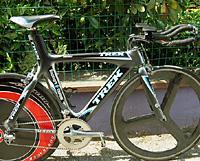Tech News – May 30, 2005
Edited by John Stevenson
Got tech? Send press releases, news, and tech questions to the
Cyclingnews tech desk.
Paolo Savoldelli's Trek Discovery Channel Team Time Trial bike
Paolo Savoldelli's Discovery Channel
Team Trek Time Trial bike.
Photo ©: Tim Maloney

|
Bikes don't win races, but having the right equipment sure helps, especially
in the nowhere-to-hide discipline of time trialling. Discovery Channel's
Paolo Savoldelli victory in the most exciting Giro d'Italia in years largely
came down to defeating his arch rival, Gilberto Simoni, in the time trials
and limiting the damage in the mountains.
The seat tube extends almost
to the saddle
Photo ©: Tim Maloney

|
|
Bontrager Race XXX Lite Carbon
Aerobar
Photo ©: Tim Maloney

|
|
Savoldelli beat Simoni by just 28 seconds in this year's Giro and the
advantage he gained from his TT bike was said to be crucial. In 80.15km
of total time trials at the 88th Giro, Savoldelli beat Simoni by a total
of 3:26 against the watch.
Trek's designers say that its Team Time Trial bike features proven aerodynamics
and a OCLV HC Carbon Frame, designed to lower air resistance but be light
and stiff to transmit power to the road.
Savoldelli's Trek Team Time Trial is equipped with a Shimano Dura-Ace
group and a complement of Bontrager equipment, including an Aero TT Carbon
Fork, and the Race XXX Lite Carbon Aerobar, which features a high compression
carbon fibre structure with internal cable routing, adjustable arm rests
and carbon extensions for a personal fit for Savoldelli. The 2005 Giro
winner parks his posterior on a Bontrager Race X Lite saddle, with optimized
full-carbon base and SSL Hollow Ti rails.
FSA responds
After our review of
FSA's RD-488 wheels at the end of last week, Ric Hjertberg of FSA
offered the following explanation, clarification and advice about a couple
of the points Dave Langley raised.
It's certainly true about the valve hole, writes Hjertberg.
The diameter is incorrect and will be enlarged. Thanks to my haste,
your set wasn't supplied with the valve extenders, extra long spoke
wrench, and composite brake pads that will accompany the others. But,
our extenders don't fit in the valve hole! We've a bit of work to do.
FYI, freehub noise is related to lubrication. When coated with a barely
perceptible film of grease, the mechanism is loud. With a teaspoon ixn
the pawl area, it's nearly silent. We're trying to get the factory to
be more uniform in this area. Here's the instruction on disassembly:
Disassembling an RD-400/RD-600/RD-800 rear hub
(1) Insert 5mm allen wrenches into each end of the hub. Loosen and
remove which ever side comes off.
(2) Re insert the allens. This time one will go into an end cap and
one into the axle itself. Loosen and remove the second cap.
(3) Push the axle, with the freehub body, out to the drive/right side.
If stuck, give the axle a little tap with a short 2x4 or soft mallet.
(4) Slide the axle out of the freehub body.
When reassembling, the pawls may need a bit of encouragement to lie
down as the freehub enters the hub shell. Use your finger while turning
the freehub gently in the freewheeling direction.
We like to use a heavy oil (Phil or 50W) in the pawl area rather than
grease. Oil won't last as long, so take the assembly apart once a year
(or 4 times if you're in Seattle/Vancouver), wipe down, reoil, reassemble.
If you're lazy, use a light grease.
More lube = less noise.
Ric Hjertberg
Full Speed Ahead
|





